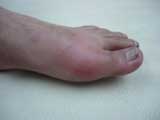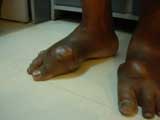 Gout |
 Chronic Grout |
Gout manifests as sudden swelling and severe pain, usually in a single joint. This swelling is an inflammatory response within a joint following deposition of uric acid crystals. Uric acid is a normal constituent of our body formed during the disintegration of senescent cells and from the degradation of certain food items containing high levels of purines. Gout is the most common form of inflammatory arthritis in men (5-27 per 1000 men). Gout rarely occurs in children and premenopausal women. Raised uric acid in children can be due to inborn errors of metabolism.
Gout is an ancient disease described by Hippocrates as well as in classical Ayurveda texts. It has affected many great personalities, especially the wealthier ones, such as kings and emperors. Three Indian studies indicate that about 65% of patients are from the middle socioeconomic class. The prevalence of gout appears to be increasing, although public awareness about the condition is extremely poor. Gout has a familial predisposition in about one-sixth of cases, and certain genetic factors are a significant risk for the development of gout.
Causes
Most cases of gout do not have an identifiable cause (primary gout). High uric acid levels are found in patients with severe kidney disease due to insufficient excretion and some cancers due to excessive formation. Uric acid can rise temporarily during strenuous exercise, starvation, and dehydration. Meat, seafood, sugary drinks, and alcohol (especially beer) are the most important food items that increase uric acid levels. Dietary excess of these items can trigger an attack of arthritis. Pulses and poultry contain moderate quantities of purines. The purine content of milk, eggs, and vegetables is negligible.
Some drugs that increase uric acid levels are - low-dose aspirin, diuretics (drugs that increase urine output), those used in tuberculosis, e.g., ethambutol, pyrazinamide, and a few drugs used in the treatment of cancer and AIDS.
Raised uric acid levels can also be seen in severe psoriasis, hypothyroidism, lead intoxication (use of herbal compounds), sickle cell disease, and certain forms of anemia. Vitamin C (citrus fruits) and coffee appear to prevent arthritis attacks in patients with raised uric acid levels.
Features
Gout is a chronic disease that manifests in 4 stages.
- Uric acid may be raised without any arthritis.
- Acute attack - An acute attack of gout manifests as exquisite pain and warm pink shiny swelling, usually at the base of a great toe (podagra). The pain usually starts early in the morning during cold weather following a high-protein dinner along with alcohol. Unless treated, the severity of pain increases rapidly over a couple of days. It regresses over a week or so, along with peeling overlying skin. Acute gout usually occurs in a single joint, although it may affect multiple joints simultaneously in about 15% of cases. Other joints such as knees, ankles, and wrists may also be involved.
- Inter-critical gout - This is a pain-free period during two attacks of acute arthritis. 62%, 78%, and 90% of patients will get a second attack within one year, two years, and five years, respectively.
- Chronic gout - Quality of life decreases with progressive gout. Urate crystals accumulate in joints and destroy them. Tophi (nodular masses of white chalky paste-like material containing urate crystals) around joints develop ten or more years after the first attack. Tophi can be found in hands, feet, knees, elbows, pinna of ears, and other sites. They can ulcerate and extrude pasty material.
- Kidney disease - Kidneys can be damaged due to uric acid in many ways. The crystals can cause swelling of the interstitium, occlude the excretory system in the kidneys, or form stones within the kidneys.
Investigations
Acute gout is a clinical diagnosis that should preferably be established by aspiration of joint fluid and demonstration of urate crystals. Joint aspiration is necessary to rule out other causes (e.g., septic arthritis)of swelling in a single joint. Aches and pains with raised uric acid are not due to gout. The normal uric acid level in the blood is up to 7 gm/dl in men and up to 6 mg/dl in premenopausal women. Uric acid levels in the blood may not be elevated in all cases of acute gout. Measurement of urinary uric acid and kidney function is required in some cases. X-ray of the involved joint shows swelling in the acute stage and damage in later stages.
Obesity, hyperlipidemia (raised cholesterol and other lipids), diabetes, hypothyroidism, and hypertension can accompany gout. Therefore, these conditions need to be suitably investigated.
Treatment
An acute attack of gout responds well to painkillers that reduce swelling (anti-inflammatory drugs). Steroids can be used orally or injected into the joint in selected cases. Allopurinol should not be used in the acute stage. It dissolves crystals within the joint and does not allow swelling to subside. Terminating an attack of gout is not the only therapy; preventing further attacks and other risks is equally essential. Allopurinol should be used after 2-3 weeks the swelling has completely subsided. The dose of allopurinol should be adjusted to maintain blood uric acid levels less than 6 mg/dl. Allopurinol dissolves crystals and excretes uric acid through urine. Allopurinol can cause digestive upsets, hair loss, skin rashes, headaches, and other adverse effects in a few cases. Febuxostat is another drug with similar action. It can be used in patients with kidney dysfunction and elderly individuals. Many high-end medications are in the pipeline. Some drugs (such as losartan and atorvastatin) used for other conditions also reduce uric acid levels to some extent. Raised uric acid to 8 mg/dl without joint disease does not require any treatment.
Diet in gout - Avoidance of meat, fish, alcohol, and sugary drinks is necessary. Dairy products, pulses, and vegetables should not be avoided. Such restrictions do not reduce uric acid levels substantially and lead to protein malnutrition. Reducing weight by controlling fats and oils is desirable. Adequate water intake (up to 2 liters/day) is also essential.
Gout and Lifestyle
Gout is a lifestyle disease and a component of metabolic syndrome along with raised blood pressure, obesity, stress, and diabetes. It carries a higher risk of heart disease if uric acid levels remain higher than 8 mg/dl. Control of weight and avoidance of stress is crucial. Patients with gout are known to be non-compliant. Therapy must be continued throughout life with regular blood checks for uric acid.
